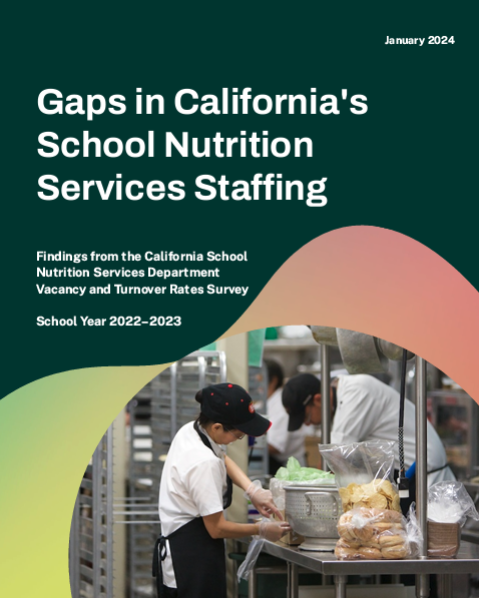This resource is provided by ACSA Partner4Purpose Lozano Smith.
On April 25, 2024, the United States Department of Agriculture’s (USDA) Food and Nutrition Service published updated school nutrition standards that will go into effect on July 1, 2024. The rule, entitled Child Nutrition Programs: Meal Patterns Consistent With the 2020-2025 Dietary Guidelines for Americans (2024 Rule), will require schools nationwide to alter their meal programs.
The USDA is required by law to develop school nutrition standards that reflect the goals of the most recent edition of the Dietary Guidelines for Americans. The 2024 Rule continues this ongoing effort to make science-based improvements to school meals and other USDA Child Nutritional Programs (CNP).
Nutrition Requirements
The 2024 Rule’s nutrition requirements address added sugars, milk, whole grains, and sodium.
Added sugars in school meals were previously unregulated by the USDA. The 2024 Rule, however, imposes both product-based limits and a weekly dietary limit. The product-based limits, which go into effect starting July 1, 2025, are as follows:
- Breakfast Cereals: No more than six grams of added sugars per dry ounce;
- Yogurt: No more than two grams of added sugars per ounce; and
- Flavored milk: No more than ten grams of added sugars per eight fluid ounces unless sold as a competitive food for middle and high schools, for which the limit is 15 grams of added sugars per 12 fluid ounces.
The weekly dietary limit requires that less than ten percent of the weekly calories in school lunch and breakfast programs come from added sugars, starting July 1, 2027.
Current milk nutrition requirements are largely maintained by the 2024 Rule, except for the product-based added sugar limit applied to flavored milk. Similarly, current whole grain requirements are generally maintained by the 2024 Rule. Beginning July 1, 2027, the 2024 Rule requires schools to abide by its revised sodium limits, resulting in an approximate 15 percent reduction in lunch program sodium content and an approximate ten percent reduction in breakfast program sodium content.
Menu Planning
The 2024 Rule is designed to provide schools with more menu flexibility, including making it easier to substitute meat or meat alternates for grains in school breakfast programs and to serve nuts and seeds as meat alternates in CNPs. The requirements for substituting vegetables for fruit at breakfast are simplified (with even broader options for substitution allowed through the 2024-2025 school year). Requirements for serving beans, peas, and lentils at lunch is also simplified, making it easier for schools to hit their target number of servings per week. Outside of provided school meals, “bean dips” are now exempt from the total fat standards applied to food sold on campus during the school day.
After-school snack standards have also been adjusted and the definition of “child” is clarified to mean children under the age of eighteen at the beginning of the school year. This change means that adult high school students may receive reimbursable National School Lunch Program (NSLP) after-school snacks throughout that school year and do not lose access to them when they turn 18 years old.
Traditional Indigenous foods may be served as reimbursable school meals, and school food authorities that are tribally operated, operated by the Bureau of Indian Education, and serve primarily American Indian or Alaska Native children, may substitute vegetables for grains.
Program Operations
Several program operations practices are modified in the 2024 Rule. Artificial “trans fats” are no longer prohibited in NSLP, the School Breakfast Program, and in food sold outside of school meals on campus during the school day. Schools may serve water with added fruits, but not as a substitute for “plain water;” “plain water” must still be offered during meal service. The standards and procedures for disability-related meal modifications have also been updated. Additional discretion is afforded to schools regarding the hiring of school nutritional program directors for medium and large local educational agencies, and preferences for “local” products.
However, “Buy American” requirements are bolstered. “Buy American” currently requires school food authorities to purchase domestic commodities or products to the maximum extent possible, with limited exceptions regarding product availability and/or cost. The 2024 Rule expands on this requiring schools to maintain documentation regarding its use of exceptions, provides a definition for “substantially” in the context of use of agricultural commodities produced in the United States, and addresses purchases of farmed and wild fish. Beginning July 1, 2024, these “Buy American” requirements are applied to purchases and contracts for food used in school lunch and breakfast programs. Additionally, the 2024 Rule phases in a cap on the amount of non-domestic purchases a school may utilize under the “Buy American” exceptions:
- Ten percent cap on non-domestic products starting July 1, 2025.
- Eight percent cap on non-domestic products starting July 1, 2028.
- Five percent cap on non-domestic products starting July 1, 2031.
Takeaways
The 2024 Rule contains several rules requiring schools to significantly alter their meal programs. The new nutritional standards will not be in effect until July 1, 2025, at the earliest, and the increased menu planning flexibility is available starting July 1, 2024. The changes to “Buy American” provisions are effective July 1, 2024. Schools should begin evaluating their meal programs as soon as possible and take the appropriate steps to come into compliance. If needed, the USDA offers compliance assistance.
If you have any questions about the USDA’s current or updated nutrition standards, please contact any attorney at one of Lozano Smith’s eight offices located statewide.



































